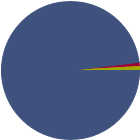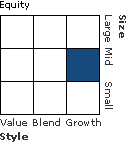| Neuberger Berman AMT Mid-Cap Growth I |
|
 |
|
| Release date as of 2025-09-30. Data on page is subject to change. |
|
|
Overall Morningstar
Rating™
|
| What is this?
|
|
 |
| As of 2025-09-30 |
|
Out of 476
Mid-Cap Growth Funds
|
|
|
|
|
|
| Total Fund Assets ($ Mil) |
| 575.22 |
|
|
|
| Investment Objective & Strategy |
|
| The investment seeks growth of capital.
|
|
| To pursue its goal, the fund normally invests at least 80% of its net assets in common stocks of mid-capitalization companies, which the adviser defines as those with a total market capitalization within the market capitalization range of the Russell Midcap® Index at the time of purchase. The fund seeks to reduce risk by diversifying among many companies, sectors and industries. |
|
|
| Morningstar Category: Mid-Cap Growth |
|
| Some mid-cap growth portfolios invest in stocks of all sizes, thus leading to a mid-cap profile, but others focus on midsize companies. Mid-cap growth portfolios target U.S. firms that are projected to grow faster than other mid-cap stocks, therefore commanding relatively higher prices. Stocks in the middle 20% of the capitalization of the U.S. equity market are defined as mid-cap. Growth is defined based on fast growth (high growth rates for earnings, sales, book value, and cash flow) and high valuations (high price ratios and low dividend yields).
|
|
|
| Mid Cap Funds: The securities of companies with market capitalizations below $10 billion may be more volatile and less liquid than the securities of larger companies. |
|
|
| % of Net Assets |
 |
U.S. Stocks |
98.1 |
 |
Non-U.S. Stocks |
1.0 |
 |
Bonds |
0.0 |
 |
Cash |
0.9 |
 |
Other |
0.0 |
|
|
 |
| Data through 2025-09-30 |
|
|
|
|
| Morningstar Equity Sectors |
|
|
|
% of Stocks |
 |
Cyclical |
26.96 |
 |
Basic Materials |
0.00 |
 |
Consumer Cyclical |
19.10 |
 |
Financial Services |
7.86 |
 |
Real Estate |
0.00 |
|
|
|
 |
Sensitive |
55.57 |
 |
Communication Services |
9.16 |
 |
Energy |
0.00 |
 |
Industrials |
21.10 |
 |
Technology |
25.31 |
|
|
|
 |
Defensive |
17.47 |
 |
Consumer Defensive |
1.43 |
 |
Healthcare |
13.45 |
 |
Utilities |
2.59 |
|
| Data through 2025-09-30 |
|
|
| Total Number of Stock Holdings |
64 |
| Total Number of Bond Holdings |
0 |
| % of Net Assets in Top 10 Holdings |
29.38 |
|
|
| Turnover % |
(as of 2024-12-31) |
96.00 |
| 30 Day SEC Yield % |
--- |
|
|
Sector |
P/E |
% of Net
Assets
|
 |
 |
 |
 |
 |
 |
Roblox Corp Ordinary Shares - Class A |
 |
--- |
3.98 |
 |
Cloudflare Inc |
 |
--- |
3.36 |
 |
Royal Caribbean Group |
 |
19.15 |
3.34 |
 |
Robinhood Markets Inc Class A |
 |
70.09 |
2.81 |
 |
Howmet Aerospace Inc |
 |
56.68 |
2.75 |
 |
 |
Zscaler Inc |
 |
--- |
2.72 |
 |
Datadog Inc Class A |
 |
448.77 |
2.67 |
 |
Carvana Co Class A |
 |
69.33 |
2.60 |
 |
Hilton Worldwide Holdings Inc |
 |
37.76 |
2.59 |
 |
Vistra Corp |
 |
30.21 |
2.56 |
 |
|
 |
|
|
|
|
|
| Event-Driven Investment/Arbitrage Strategies, Lending, Foreign Securities, Loss of Money, Not FDIC Insured, Growth Investing, Issuer, Market/Market Volatility, Industry and Sector Investing, Other, Pricing, Increase in Expenses, Shareholder Activity, Management, Mid-Cap |
|
| Show Risk Definitions |
|
|
| Inception Date: 1997-11-03 |
|
| Trevor L. Moreno (2020-01-31) |
|
| Trevor Moreno, CFA, Managing Director, joined the firm in 2014. Trevor is a Co-Head of the Growth Equity Team and a Senior Co- Portfolio Manager on our Small Cap Growth and Mid Cap Growth strategies. In addition, he has Team research responsibility for the Information Technology and Communication Services sectors. Prior to joining the firm, he held assistant portfolio manager and analyst positions at Wells Capital Management and Strong Capital Management before that. Trevor began his career in 2000 at Parker Hannifin Corporation as a staff accountant and a financial analyst. He earned a BS in Accounting and Finance, as well as an MBA from the Kelley School of Business at Indiana University and has been awarded the Chartered Financial Analyst designation. |
|
| Chad A. Bruso (2020-01-31) |
|
| Chad Bruso, CFA, Managing Director, joined Neuberger Berman in 2006. He is a Co-Head of the Growth Equity Team and a Senior Co-Portfolio Manager on our Small Cap Growth and Mid Cap Growth strategies. In addition, he has Team research responsibility for the Consumer Discretionary, Consumer Staples, Materials and Industrials sectors. Prior to joining the firm, he was a vice president and transportation analyst at Morgan Stanley. Chad began his career in 1998 as a senior consultant at Arthur Andersen. He earned a Bachelor of Finance from the University of Illinois at Urbana-Champaign and has been awarded the Chartered Financial Analyst designation. |
|
| Jennifer Blachford (2021-12-20) |
|
| Jennifer Blachford, Senior Vice President, joined the firm in 2019. She is an Associate Portfolio Manager on the Growth Equity Team and a Co- Portfolio Manager on our Small Cap Growth and Mid Cap Growth strategies. In addition, she has Team research responsibility for the Health Care sector. Prior to joining, Jennifer served in a variety of senior roles including Portfolio Manager at Arcoda Capital Management. Jennifer began her career in 1998 as an analyst at Suffolk Capital Management. She earned an BA from Princeton University. |
|
|
|
| Neuberger Berman Investment Advisers LLC |
|
|
|
|
|
|
|
|

© Copyright 2025 Morningstar, Inc. All rights reserved. Morningstar, the Morningstar logo, Morningstar.com, Morningstar Tools are either trademark or service marks of Morningstar, Inc. The information contained herein: (1) is proprietary to Morningstar and/or its content providers; (2) may not be copied or distributed; and (3) is not warranted to be accurate, complete or timely. Neither Morningstar nor its content providers are responsible for any damages or any losses arising from any use of information. Past performance is no guarantee of future performance. |
|
Past performance is no guarantee of future results.
Returns will vary and shares may be worth more or less than their original cost when sold.
|
|





















